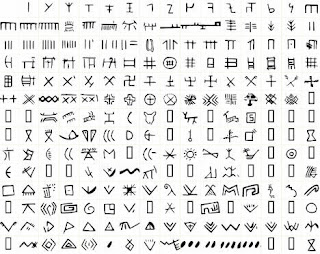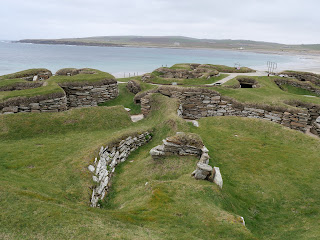Whether Neolithic "incised art" found scratched into stones at Wideford and Cuween cairns, at Skara Brae, Barnhouse and Stenness is a type of written proto-written language would be no surprise.
 |
| Site description of Wideford Hill cairn Neolithic "marks" |
The level of sophistication demonstrated by our Stone Age predecessors in site after site is remarkable. Too often in our chauvinism of time, we presume restrictions upon the KSA (knowledge, skills and abilities) of Stone Age predecessors. "Oh, they couldn't have done this or that; they were primitive in mind." And so on.
It is as if we presume a barrier exists between modern day humans and those generations in prehistory before us.
But are we really so
different? Did they not love as dear? Are we not just as covetous?
Were they any less oppressive, or we any more compassionate? Could they
not imagine just as well? In our hubris, our generation ignores the Prophet Jeremiah's question on the nature of humankind: "Can the Ethiopian change his skin, or the leopard his spots?" Jeremiah 13:23.
This two part post will use maritime trade in Neolithic Orkney as an
example of
how we too often short change our creative Neolithic forebears.
Archaeologists have long been mistaken regarding humankind's navigation
of the seas, for example. Humans (H. sapiens as well as H. erectus) took to the seas many tens
of thousands of years earlier than once the discipline of archaeology
believed.
 |
| Site description Cuween cairn Neolithic "marks" |
As Boston University archaeologist Curtis Runnels admits after excavations on Crete left little doubt about Paleolithic era oceanic navigation of H. erectus, "We severely miscalculated."
By similar measure, "conventional thought" presumes Orkney's Neolithic people did not possess a written language "system". Or at least that seemed to be the opinion of a docent at Skara Brae, a Late Neolithic village on Mainland Orkney in which "incised art" or "marks" were uncovered. "Oh, they couldn't have..."
Self sure of his purported expertise, the docent barely contained a sneer at the mere question. With all the air of absolutism, what flowed from the fellow was an insufferable ten or more minutes of an oral dissertation. Bottom line: not possible...at least according to that guy.
 |
| Diagram of Neolithic Skara Brae "marks" |
Two are uniquely different--an incised three spiked mace head type of
object, and a stone "bed" inside one of the Neolithic houses. Perhaps a mere layman's opinion here, but an outright dismissal of the Orkney Neolithic people possessing a proto-written language seems to be..."severely miscalculated".
Enduring the gentleman's intolerable elitism, it was clear. No conversational exchange would happen. So we moved on. We began our tour of Skara Brae ourselves, leaving the fellow in mid-sentence, or perhaps mid-chapter. He had the final word, assuming he ever got to it.
 |
| Site description other Cuween cairn "marks" |
Like navigation on the seas, Neolithic use of written language or symbolic "marks" occurred much earlier than once was assumed. By its nature, archaeology discovers more and more with each new dig. An expanding Neolithic repository puts previous "absolute" assumptions--like those dismissing an earlier Neolithic proto-written language--into question.
 |
| From T. Nacevski--undeciphered Vinča written symbols |
Advanced for its day, the Vinča culture (c. 5700 BC - 4500 BC) smelted copper well before metallurgy was attributed to Anatolia and the Fertile Crescent. Their joinery (which has been preserved in several well casings sunk into Danubian riparian farmstead sites) was extraordinary...dovetail, mortise and tenon...all created with stone and bone tools evidencing superior craftsmanship.
 |
| Neolithic built-in cabinets Skara Brae April 12,2022 |
While conclusions may be disputed, it does seem the Vinča culture had a proto-writing system well before its innovation was attributed to Mesopotamia.
 |
| Skara Brae--April 12, 2022 |
The "country sister" of the Vinča was the Linear Band Ware (LBK) people (c. 5500 BC - 4500 BC). These were Neolithic frontier ranchers and farmers on the western perimeter of the Vinča culture who pushed westward up the Danube and into "frontier" Mesolithic Europe. Initially, their principal trade was down river, behind them. But with westward expansion, over the narrow headwaters of the Danube and down the Rhine to the North Sea, trade route distances grew.
The extended trade routes gave rise to a new industry...the beginning of a dairy industry, and specifically cheese making. The LBK's principal trade commodity was cattle--and increasingly more for dairy than for meat. They did trade leather, a valuable by-product of cattle husbanding, but cattle were evermore valued as draft animals for opening new agricultural ground deeper in western Europe. Milk is highly perishable. So necessity developed cheese making, providing the LBK with a form of "self stable" dairy commodities for trade. In this, the LBK also left an indelible genetic imprint in Europe--namely, lactose tolerance. The trait affords competitive advantages that are limited in other parts of the world.
 |
| Skara Brae house and hearth--April 12, 2022 |
Agriculturally, the LBK planted small plots or gardens--more as subsistence agriculture than commodity trade. Crops included emmer and einkorn wheat, peas, lentils and barley. They also grew hemp and flax for rope and cloth, and poppies apparently for medicine. Domestically, the LBK manufactured linear incised pottery, hence the name of the culture. The incised lines imitated painted (and complicated) Vinča pottery.
At the least, the Neolithic "marks" in the Vinča pottery (also known as Old Danube Script) may "only" be potter's or perhaps owner's marks. But these convey meaning even so. And there are unique Vinča symbols placed at the base of their pottery possibly indicating the contents, or perhaps its trade destination, which alone implies geographical knowledge of widespread trade routes. Lastly, "comb-like" symbols evidently were a form of counting, evidence of early Neolithic use of mathematics in trade. No surprise, since many Neolithic standing stone monuments are oriented with solar or lunar cycles which entails observational mathematics.
 |
| "Streets" of Skara Brae--April 12, 2022 |
These may have been primitive people, yes. But they were by no means ignorant. And the Orkney Neolithic people apparently had far more extensive contact (via oceanic trade) with continental Europe than has been widely presumed, specifically with Belgium. So to dismiss out of hand all Neolithic "incised art" on Orkney's monuments and to presume that no proto-written language existed at this time is preemptive at best, or presumptive, if not downright "severely miscalculated".
No comments:
Post a Comment